 |
 |
|
 |
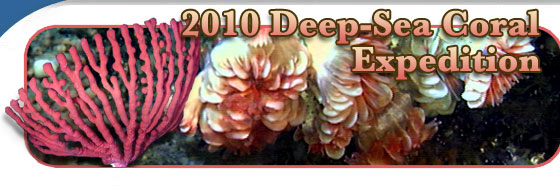
Error processing SSI file
|
Blog June 12, 2010:
Patience, Patience, Patience
Jennifer Bright
Olympic Coast National Marine Sanctuary
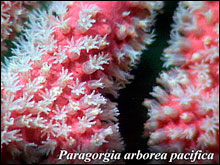 |
| Dreaming of corals, an image of Paragoria from the 2008 deep
sea coral cruise. |
While we were transiting to the outer coast of Washington's Olympic Peninsula I was wondering if things would run smoothly on our first day of diving. I have high expectations of getting the remotely operated vehicle (ROV) into the water and viewing the first deep sea corals of our 2010 research cruise. Since today is my birthday, it would be a great gift to have the bugs worked out and collect some good video footage from the ocean bottom. Last night, instead of dreaming of sugar plum ferries, I was dreaming of Paragorgia, Primnoa, Swiftia, and Lophelia, some of those beautiful deep sea coral species we expect to see out here.
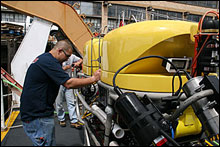 |
| Rudy Schlepp installs components on the ROV. |
Now that we have arrived at our first dive site in Olympic Coast National Marine Sanctuary, we are in the process of completing final ROV testing. The initial dunk test, so to speak. In the dry lab (video capture and review) and wet lab (sample processing) the team is a buzz of activity practicing as if we were real time annotating the dive and collecting samples from the containers on the ROV. Some of the team leaders got off the ship after the shakedown and are missed by the remaining team members. We are all full of excitement and anticipation for the dives to begin. That should happen later today.
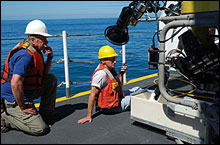 |
| Dennis Arbige makes adjustments to the mechanical arm as Ed
Bowlby looks on. |
Working with realistic space and budgetary constraints can be difficult when performing research. For example, our ROV team could always use additional staff experts to help insure a perfect mission. However, such a desire is just not feasible primarily due to the limited amount of bunk space onboard the vessel. For example, we could always use extra information technology (IT) and video technicians. But in reality scientists have to be highly multi-disciplinary and learn as much as possible outside of their professional and academic training in order to accomplish mission objectives. Today we are working out the bugs of our systems and running tests to determine technical problems before they occur underwater when we need to be gathering important data.
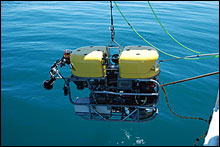 |
| ROV during its first dunk test to check equipment and buoyancy. |
While working out the bugs we have biologists troubleshooting IT and video issues. No matter how prepared a mission is, equipment will always fail and it is up to the ingenuity of the team to overcome obstacles that are outside their expertise. Although at times highly stressful, the excitement involved in high stakes research activities is just as enjoyable for the team as satisfying our curiosity of the ocean ecosystems below. There are moments when it seems as though a minor equipment failure could jeopardize the entire mission, yet the team is able to overcome the problem and the mission continues. Perseverance and patience are critical for a successful research cruise.
|
|
 |



